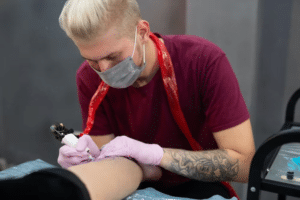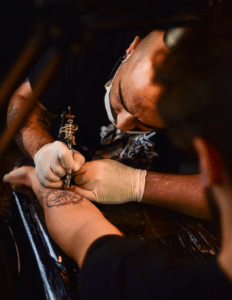How Long Do You Have To Wait After a Tattoo Before You Can Swim?

Source: pexels.com
You just got a new tattoo and are eager to show off at the pool this summer. But wait! How long after getting a tattoo, can you swim?
When it comes to displaying new tattoos, there is a temptation to show off-but proceed with caution. In the case of a new tattoo, the skin is essentially a fresh open wound and must be allowed to heal without being exposed to harsh weather conditions. In particular, you should protect it from bacteria, sunlight, chemicals, pollution, and water–especially when you swim. Saltwater and chlorine can both damage new tattoos, particularly if they are very elaborate. As a result, you should try avoiding the pool or the beach until your tattoo has completely healed.
The answer to how long you have to wait before swimming after getting a new tattoo depends on the type of tattoo and the type of swimming you plan to do.
Why You Shouldn’t Swim With a New Tattoo
Tattoos are vulnerable to infection until they fully heal. Microbes such as bacteria can get into the skin from pools, lakes, and oceans because the water is not sterile. Further, if chemical substances (such as chlorine in a pool) are allowed to enter the healing skin, this can result in increased fading or discolouration of the tattoo colour. It is important to keep in mind that the salt and/or chemicals in a pool can damage the skin and your amazing new tattoo, depending on the skin type, tattoo size, and location on the body. There are many symptoms of this, such as irritation, discomfort, infection, and even ink being pulled from the skin.
A tattoo can fade and discolour over time if you swim in chlorinated water. Until your new tattoo has had enough time to heal, avoid swimming in pools if you can.
If you can’t resist swimming, here are some tattoo aftercare tips:
Try to Keep the Tattoo Dry
If you want your tattoo to heal correctly, you should avoid contact with water at first, whether it’s in the sea or the pool. Water should not be exposed for extended periods, as it may displace the ink or alter the colour of the tattoo. If you wish to preserve the colour of your tattoo, avoid bathing in rivers, pools, and jacuzzis. If you have a wound that is exposed to pool water, for example, your open wound is at risk of infection. This is also the case for tattoos because a fresh tattoo is a wound. In swimming pools, disinfectant products are used to treat the water, which does not mix well with wounds.
You must also avoid gyms in order to speed up your healing process. Muscles stretch the skin, and sweat is produced when you exercise. The healing time can be slowed down if you stretch the skin and sweat excessively near your tattoo.
Let Your Tattoo Breathe
During the first few hours following the tattoo session, your tattoo artist will apply cling film to protect your tattoo from bacteria. As soon as you remove the dressing from the wound and clean it for the first time, allow your skin to breathe as much as possible.
You can speed up the healing process of your skin by breathing fresh air. Make sure your tattoo is exposed to the air as often as possible so that it can heal in the best possible conditions. If you want to buy bedding and clothes, choose natural materials, like cotton, instead of synthetics.
Keeping tattoos moist will prevent scabbing, which can happen when they dry out. Healing balm should not be applied more than necessary to speed up the healing process. An overly thick layer prevents your tattoo from breathing. In order to ensure that the cream penetrates deeply, massage the balm in a circular motion after applying it.
Keep the Tattoo Wound Clean All the Time
Your tattoo artist applied a dressing with cling film to the wound after the session to prevent infection. If your tattoo artist instructs you to take off the dressing after three to six hours, you can clean the area for the first time after that. People enjoy this step because it’s the first opportunity to see the results of their tattoo after the residual ink and blood have been washed away.
Ensure that your hands are thoroughly washed before cleaning the wound. Flannel or other exfoliators should be avoided when rubbing a tattoo. Bacteria may be present in them and increase the risk of wound infection. You should only use clean hands. A gentle, unscented soap should be used to clean them. Skin can be irritated or dried out by cosmetic products containing alcohol or certain chemicals. In turn, this can slow the healing process.
To gently dry your tattoo after cleaning the wound, use a clean towel or kitchen roll. It won’t take long to be able to get back to the pool if you consistently follow this routine twice a day, morning and night.
Shower with Care
You do not need to protect your tattoo in the shower with cling film or plastic bags, but don’t let the water run over it for too long.
Use lukewarm water and take quick showers. Make sure your shower head is not pointed directly at the tattoo if your shower pressure is high. As long as you don’t spend too much time in the shower and don’t allow the water to run over your tattoo area, showering isn’t necessarily a problem.
It does not matter if you get it slightly wet as long as it is a small amount of water. As a matter of fact, it will need to be wet in order to be cleaned.
Protect Your Fresh Tattoo
It would be ideal if you could refrain from swimming for the entire healing period after getting a tattoo. However, if it’s absolutely necessary to get in the water during the healing process, make sure you take precautions to protect your tattoo.
Using a protective cream will help protect your wound. Wearing a waterproof bandage over it will be the safest thing to do while swimming. Several of these items are readily available at pharmacies. These are available over-the-counter in most drugstores. Ensure the tattoo is completely covered by the bandage. If you have been swimming, you should dry the area, remove the bandage, and gently clean the area with soap and water as soon as possible. Afterwards, pat the wound dry and resume normal wound care.

Source: pexels.com
Conclusion
Ideally, you should refrain from swimming for three full months after getting your tattoo so that it can heal without infection concerns. It is not recommended to swim with a new tattoo. Be sure, however, to take the necessary precautions to keep your tattoo protected if you must do so. If you are going to be in the water, make sure to keep it clean and covered. It is also recommended not to swim in chlorinated pools or saltwater. You can help preserve the look of your new tattoo for many years if you follow these guidelines.
FAQs
How do you tell if a tattoo is healed?
It is possible that your tattoo will be completely healed after 5 to 6 weeks. The final stage of the healing process is when all the dry skin and scabs are gone, revealing smooth, vibrant skin with no burning or itching.
How do you cover a new tattoo for swimming?
When swimming, you should not let your new tattoo be exposed to chlorine, salt water, and the sun. It is best not to swim when your tattoo is still healing, but if it is inevitable, you can cover your tattoo with a waterproof bandage. This way, your tattoo will not be soaked in chlorine or salt water. After swimming, make sure to pat your tattoo dry and clean it properly. Rinse it with clean water to ensure that it is free of chlorine or salt water.




